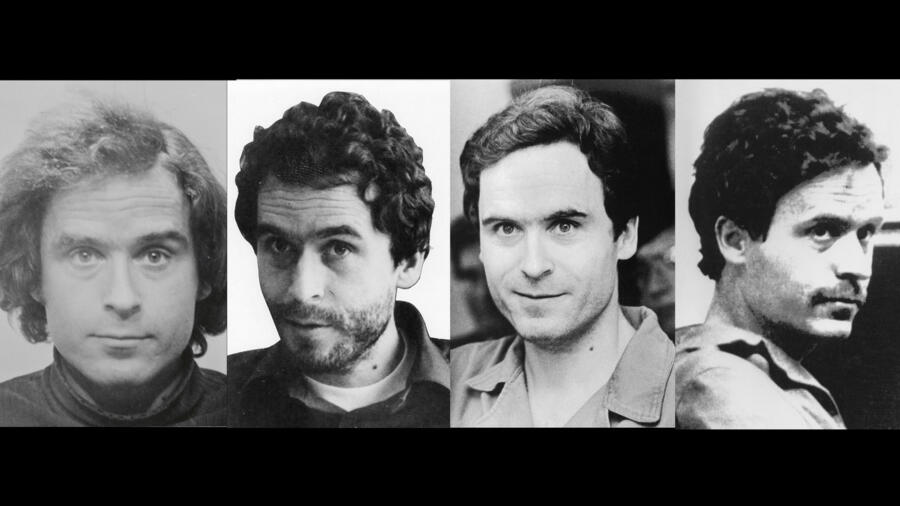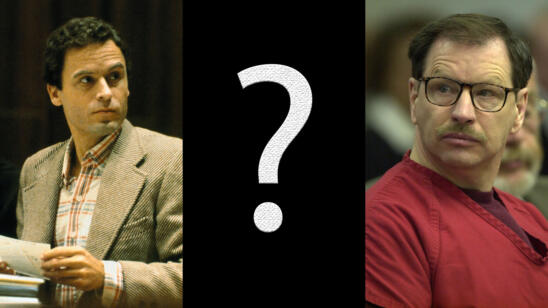When Ted Bundy was arrested in Utah and put on trial for the attempted kidnapping of Carol DaRonch, she proved to be an unreliable eyewitness. Although she remembered key details about his Volkswagen Beetle, she was unable to identify him from a mugshot. The defense pressed her on the inconsistency: it seemed odd, given her attacker hadn’t been wearing a mask and they’d interacted for several minutes.
But after viewing different photos of Bundy throughout the years, one might understand DaRonch’s confusion. Bundy had a chameleon-like ability to deftly change appearances—whether physically or with the help of costumes and props—which helps explain why the vicious killer was able to evade the law for so long. In the mid-1970s, the serial killer murdered at least 30 women across multiple states, baffling investigators for years.
Ted Bundy’s Earliest Disguises
Bundy’s different looks weren’t just a matter of his physical appearance. They were also, in part, by psychological design. Even before he began killing, says a psychologist who later examined him, Bundy showed characteristics of a sadistic misogynistic sociopath: unable to see people as people and sexually aroused by the thought of killing women. Given that constellation of personality traits, he assumed a false persona at a very early age, says Stephen Michaud, author of Ted Bundy: Conversations with a Killer, a book based on over 150 hours of interviews Michaud conducted with Bundy about his life.
[Watch Invisible Monsters: Serial Killers in America in the A&E app.]
According to Michaud, Bundy started wearing that proverbial mask in adolescence.
“When he hit puberty, moving from middle school to high school, he underwent this sudden implosion,” Michaud tells A&E True Crime. “It was 24/7 with him. Whatever chemistry… whatever was supposed to happen didn’t go right with Ted. From that time on, [he used] an assumed identity…when he first starts interacting with women, with girls.”
In those adolescent years, Michaud says Bundy “constructed a personality… Bright. Smiling. Four-square for God and Country. Ted Bundy, Republican.”
Later, Bundy turned his disguise work into something of an art form.
In 1969, at age 22, Bundy enrolled at Temple University in Philadelphia for a semester, where he took classes in acting and stage makeup. On the eve of his execution, Bundy would say he committed his first two murders on the New Jersey shore, at the end of that semester.
His dramatic flair would aid him for the rest of his killing spree. He abducted two of his victims (Janice Ott and Denise Naslund) at Lake Sammamish State Park near Seattle in broad daylight in July 1974. According to eyewitness reports, Bundy spoke to lake-goers with a British accent that day and wore his arm in a cast. In subsequent abductions, Bundy would use various props to feign injury, including arm-slings and crutches, and lure victims by soliciting their help.
When Bundy was charged with DaRonch’s kidnapping, the ruse finally failed him. She identified him from a police lineup, and he was convicted of aggravated kidnapping and sentenced to up to 15 years in Utah State Prison.
Ted Bundy’s Changing Eye Color
In addition to Bundy’s propwork, he could also physically change…sometimes mid-conversation, says Michaud. According to the author, during his Bundy interviews the killer’s face would physically change with his mood.
It started with his eyes.
“His true day-to-day eye color… He had these kind of pretty blue eyes,” says Michaud. “But when he really got going, his eyes got black.”
Michaud isn’t sure why that is, although he’s open to the idea that it might have had something to do with pupil dilation at times of heightened arousal.
In addition to the blackened eyes, Michaud also says when Bundy would concentrate hard on something, it would cause temporary facial discolorations and swelling.
“This happened three or four times,” he says. “A welt would start crossing his cheek—the right cheek, under his eye… it was so straight. It wasn’t like a scratch. It was white, or light-flesh colored—lighter than his flesh. And then, when he’d relax, it would fade.”
It’s in the Nose…
Michaud believes that part of what made Bundy so difficult to identify was “a quirk of physical makeup… He could turn his head, and…he would present differently.”
Michaud says this quirk is bound in the geometry of Bundy’s face.
“He had a very, very sharp nose in profile,” Michaud says.
The prominence of that nose is exemplified in the eyewitness testimony of Nita Neary, a Florida State University (FSU) student who saw Bundy leave the Chi Omega sorority house in Tallahassee after he committed multiple murders there. Neary recalled a “sharp, thin nose,” but little else about the killer’s appearance.
But when seen straight on, Michaud says, the prominence of that nose would disappear and the witness’s focus would go to his eyes.
Michaud adds that fluctuations to Bundy’s weight also caused his appearance to change. “His weight changed a lot,” Michaud says. “A few pounds one way or another would change his aspect very dramatically.”
After losing considerable weight while awaiting trial for a Colorado murder in 1977, Bundy was able to escape through the ceiling of his cell, where he stole a jailer’s uniform and walked out through the front door. (It was his second escape while in police custody.)
Despite a frenzied statewide manhunt in which his photo was widely distributed to the public at large, Bundy was able to get out of the Rocky Mountain State and make his way to Florida, where he was able to rent an apartment near FSU under an alias. He was able to shop for groceries and hang out at local college bars undetected. Sometimes he’d even sneak into lecture halls to listen to speakers.
There, he killed at least three young women (two from FSU), all while being pursued by the Federal Bureau of Investigation. When he was arrested in Pensacola for driving a stolen vehicle, he refused to provide identification. He spent several days in jail, and local authorities were unable to figure out who he was, even though by this point, he was on the FBI’s Top Ten Fugitives List.
Ultimately, they only learned they’d apprehended one of the most brutal serial killers in American history when he gave up his name in exchange for a phone call…to an ex-girlfriend.
Related Features:
What Was Ted Bundy’s Execution Like?
Ted Bundy’s Childhood: Lonely Boy to Window Peeper to Serial Killer
The 5 Most Bizarre Moments from Ted Bundy’s Murder Trials
Ted Bundy, the Sexiest Serial Killer?
Why Are Some Women Sexually Attracted to Serial Killers?


